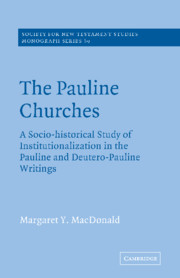 The Pauline Churches
The Pauline Churches Published online by Cambridge University Press: 10 December 2009
1 Timothy, 2 Timothy, and Titus reflect the continuation of the Pauline movement into the second century. However, in these writings one discovers a very different style of religiosity from the type found in the authentic epistles or in Colossians and Ephesians. The Pauline symbolic universe has been transformed in relation to the changed social situation. The following study considers the historical circumstances that acted as catalysts to change.
Despite the great differences among the writings of the Pauline corpus, it is evident that some continuity exists. For example, the authority of the Apostle to the Gentiles is reinforced in the Pastoral Epistles and in the other letters. The ethos of love-patriarchalism continues to play a prominent role in the community life. Therefore, it is useful to consider the relationships between the Pastoral Epistles and the early Pauline writings in terms of the ongoing process of institutionalization.
Like the communities of Colossians and Ephesians, the community of the Pastorals is characterized by the changed situation that resulted from the death of the Apostle. However, the need to stabilize community life has reached crisis proportions in the community of the Pastorals, which is experiencing a severe conflict surrounding the problem of false teaching. Social mechanisms are brought into play in order to safeguard the church from destructive forces. The authority of official leaders as the protectors of sound teaching is emphasized.
To save this book to your Kindle, first ensure [email protected] is added to your Approved Personal Document E-mail List under your Personal Document Settings on the Manage Your Content and Devices page of your Amazon account. Then enter the ‘name’ part of your Kindle email address below. Find out more about saving to your Kindle.
Note you can select to save to either the @free.kindle.com or @kindle.com variations. ‘@free.kindle.com’ emails are free but can only be saved to your device when it is connected to wi-fi. ‘@kindle.com’ emails can be delivered even when you are not connected to wi-fi, but note that service fees apply.
Find out more about the Kindle Personal Document Service.
To save content items to your account, please confirm that you agree to abide by our usage policies. If this is the first time you use this feature, you will be asked to authorise Cambridge Core to connect with your account. Find out more about saving content to Dropbox.
To save content items to your account, please confirm that you agree to abide by our usage policies. If this is the first time you use this feature, you will be asked to authorise Cambridge Core to connect with your account. Find out more about saving content to Google Drive.